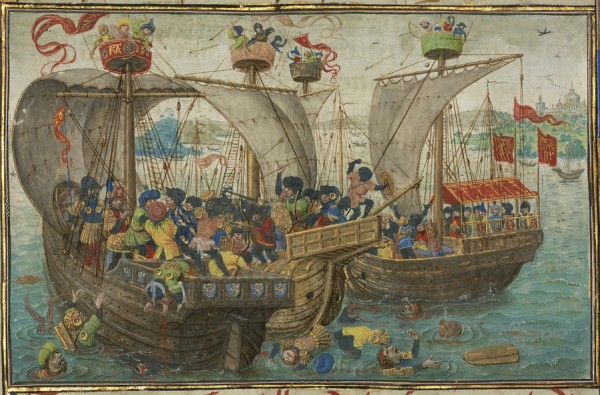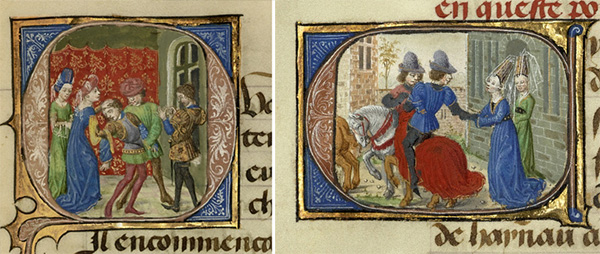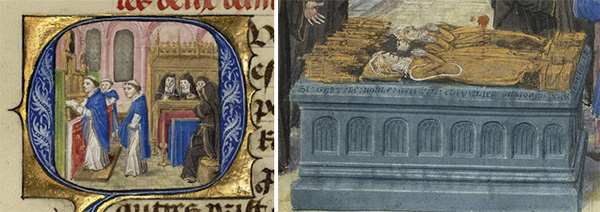In 2013, the J. Paul Getty Museum acquired a magnificent manuscript called the Romance of Gillion of Trazegnies, which tells of the tribulations in both love and battle of an adventurous medieval knight named Gillion. The manuscript’s luminous illuminations heighten and emphasize the tale’s most dramatic and important moments. Along the way, Gillion encounters nefarious villains, is tricked into thinking his twin sons are dead, and even mistakenly becomes a bigamist. Days of Our Lives, move over!
Setting the Stage

Initial P: The Marriage of Gillion and His First Wife, Marie; Initial A: Gillion and Marie Embrace in a Window; Initial Q: Gillion Kneeling Before an Altar; Initial A: Gillion Taking Leave of His Wife in Romance of Gillion de Trazegnies, after 1464, Lieven van Lathem. Tempera colors, gold, and ink on parchment, 14 9/16 x 10 1/16 in. The J. Paul Getty Museum, Ms. 111, fols. 10v, 11v, 13, 17
The story begins with a series of historiated initials (letters filled with a visual scene) telling of Gillion’s wedding and his early days of marriage. The Count of Hainaut, a powerful nobleman in what is modern-day Belgium, gives his daughter Marie in marriage to Gillion based on the young knight’s loyalty and virtuous character. As with many medieval marriages, the Count of Hainaut rewarded a dependent’s service by allowing him to marry above his own rank in society, a marriage that will increase Gillion’s status.
The next scene shows the couple blissfully holding hands in a window of their handsome castle, a happiness marred only by the absence of children. Gillion then vows to God that he will make a pilgrimage to the Holy Land in thanks if he is blessed with children. When Marie gives the joyful news of her pregnancy, Gillion duly sets off for the East, saying a poignant goodbye to his wife.
These four initials all occur within just a few pages, quickly establishing the basic elements from which the rest of the story will grow. Lieven van Lathem, who skillfully illuminated this luxurious manuscript, paid close attention to minute details from the narrative when planning his miniatures. For example, Marie is saddened about her childless marriage, a sadness that is heightened by watching a family of fish swimming contentedly in the moat beneath the castle here to see the little fish that Lieven van Lathem painted.
A Near-Death Experience and a Beautiful, Exotic Heroine

A Naval Battle Between Gillion’s Troops and the Soldiers of the Saracen Prince in Romance of Gillion de Trazegnies, after 1464, Lieven van Lathem. Tempera colors, gold, and ink on parchment, 14 9/16 x 10 1/16 in. The J. Paul Getty Museum, Ms. 111, fol. 21
While sailing for the Holy Land, Gillion’s ship is attacked by Saracens (Muslim warriors). Despite a valiant fight, complete with flying arrows, furious hand-to-hand combat, and daring leaps from ship to ship, Gillion’s knights are overwhelmed. The artist so cleverly captured the chaos of battle that you can almost hear the clang of sword against sword, the screams of the injured, and sound of bodies falling to the water below. Gillion is taken prisoner by the Sultan of Egypt, tossed into prison, and slated for execution.

Illumination from Roman de Gillion de Trazegnies, after 1464, Lieven van Lathem
Gillion, despairing of his life, nonetheless earns the regard of the Sultan’s exquisite and captivating daughter, Gracienne. When she sees Gillion stripped to the waist and tied to a column, preparatory to being shot with arrows, she falls hopelessly in love with him and begs her father to spare the knight’s life. As with the story many centuries later of Pocahontas, who saves John Smith from her father’s death decree, differences in race and religion cannot stop true love. The Sultan releases his captive and is subsequently so impressed with Gillion’s knightly qualities that he hires him as a mercenary to head the Saracen troops.
The Plot Thickens

Initial Q: Gillion Swooning over the News that His Wife and Sons Had Died in Hainault and Initial C: Gillion’s Sons, Jean and Gerard, Taking Leave of Their Mother in Romance of Gillion de Trazegnies, after 1464, Lieven van Lathem. Tempera colors, gold, and ink on parchment, 14 9/16 x 10 1/16 in. The J. Paul Getty Museum, Ms. 111, fols. 69 and 84v
Meanwhile, back in Europe, Marie begins to worry that Gillion has not returned. A family friend named Amaury, who secretly is in love with Marie, treacherously promises to go looking for Gillion and to help bring him home. When he finds Gillion (above left), he lies and tells him that Marie (“Really, Gillion, no need to come home”). The artist sensitively shows Gillion swooning at the news, with Gracienne there to support him and assuage his sorrow. Their twin boys, now fourteen-years-old, resolve to go in search of their father (above right), vowing to their mother to find him.
An Unwitting Bigamist

Gillion and Haldin Compete for the Attention of the Suyltan with Gratienne Kneeling (detail) in Romance de Gillion of Trazegnies, after 1464, Lieven van Lathem. Tempera colors, gold, and ink on parchment, 14 9/16 x 10 1/16 in. The J. Paul Getty Museum, Ms. 111, fol. 150v
Despite the growing love between Gillion and Gracienne, they have remained chaste, when a conniving courtier devises a plan to discredit Gillion with an accusation

Initial Q: Hertan in a Pitched Battle with King Haldin’s Champion
of unsanctioned relations between the two (as if Gillion didn’t have enough hardships!). The artist heightens the emotional aspects of the scene, with Gracienne, distraught, and Gillion, indignant (at left), defending their honor before the Sultan in the face of the evil machinations of Haldin (at right, his name written in gold letters across his scarlet tights).
The Sultan decides that a joust (at right) between the two sides will reveal the truth, with the winner being vindicated. Haldin is defeated when he is pinned beneath his horse (a specific detail carefully rendered by the attentive artist).
As might be expected, the lovers are justified, and the Sultan believes their love is true and allows Gillion and Gracienne to marry. Unfortunately for the bridegroom, he is now (unknowingly) married to two women at the same time.
And They Live (or at Least Die) Happily Ever After

Initial Q: The Celebration of Mass at the Convent of Binche and The Author Hears the Story of Gillion de Trazegnies (detail) in Romance of Gillion de Trazegnies, after 1464, Lieven van Lathem. Tempera colors, gold, and ink on parchment, 14 9/16 x 10 1/16 in. The J. Paul Getty Museum, Ms. 111, fol. 200v
When the twins find Gillion and reveal to him that not only is he the proud father of two strapping teenagers, but is also still the husband of their beloved mother, Marie, Gillion finds himself in quite a difficult predicament. As an additional matter of concern, the two wives decide to meet. If this were a modern soap opera, the scene might end badly with violence and bloodshed (not to mention bad language). The two women instantly feel like long-lost sisters and mutually agree to retire to a nunnery (above left), where they promptly and conveniently (for Gillion, that is) die.
After many more adventures, Gillion is killed on the battlefield, and his sons reverently take his heart back to Europe, where it is buried between his two devoted wives in a triple tomb. Perhaps this isn’t the classic happy ending, but it certainly makes for a great story.
___
Fond of love stories? Passionate about medieval manuscripts? The Getty’s manuscripts collection contains several classic romances, which you can browse anytime: Romance of the Rose and The Story of Two Lovers.




I really love poems like The Song of Roland or Tristan and Iseult. Both of them were my school readings. Courage, grace and honor of those heroes is inconceivable. Not like in the shallow soap opera called The Bold and the Beautiful.
Nicely written. Beautiful paintings. How did they paint so much detail in such small initials?